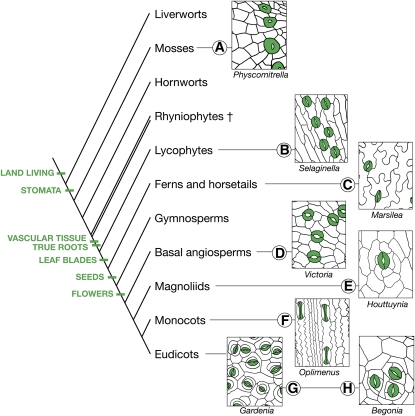Figure 1.
Diversity of Stomata across Land Plant Taxa.
A phylogenetic tree of extant and extinct (†) land plants includes evolutionary traits supporting success on land. The wide diversity of stomatal complexes among these groups is represented by epidermal tracings of P. patens ([A]; nonvascular), Selaginella kraussiana ([B]; lycophyte, vascular), Marsilea macropoda ([C]; fern, vascular), Victoria amazonica ([D]; Nymphaeaceae, basal angiosperm), Houttuynia cordata ([E]; Piperales, magnoliid), Oplimenus hirtellus ([F]; Poales, monocot grass), Gardenia taitensis ([G]; Gentianales, eudicot angiosperm), and Begonia rex-cultorum ‘Roberta’ ([H]; Cucurbitales, eudicot angiosperm). Stomata are colored green. Note that the stomata of Physcomitrella have a single GC, while the GCs of Oplimenus, a grass, have a dumbbell shape. Only Houttuynia, Gardenia, and Begonia show evidence of asymmetric amplifying divisions within the stomatal lineage. Physcomitrella is traced from a scanning electron microscopy image by L. Pillitteri.

